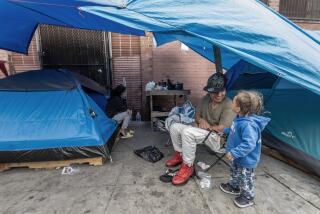Political Asylum Cases Swamp INS : Immigration: A surge of applications by Central Americans and Haitians and a critical staffing shortage are delaying hearings in thousands of cases.
A continuing migration of refugees to the United States and a critical staffing shortage within the U.S. Immigration and Naturalization Service has created an unprecedented backlog of political asylum cases, particularly in Los Angeles where the problem has reached record levels.
According to INS estimates, the number of pending asylum cases has grown from 72,000 to more than 204,000 in the last 2 1/2 years.
Once the rarefied domain of Russian ballerinas, Chinese athletes and Hungarian freedom fighters, political asylum has become one of the fastest-growing avenues of entry into the United States.
Because of the recent surge in applications for asylum by Central Americans and the unexpected arrival of thousands of Haitians after a September coup in their country, the INS estimates that the number will probably approach 300,000 by October--a crushing backlog that critics say could take years to reduce.
“It is a system on the verge of being overwhelmed,” said Arthur C. Helton, refugee project director of the New York-based Lawyers Committee for Human Rights.
Since early this year, some of the INS’ busiest asylum offices have been forced to stop working on tens of thousands of old asylum cases--some of which have languished for up to five years--to keep abreast of the new cases.
In Los Angeles, asylum hearing officers have stopped work on new cases, handling only the routine work of issuing work documents to applicants.
The sudden increase in the asylum backlog comes a year after the INS revamped its system to provide a more efficient and fair review of cases.
The change was sparked by a decade of complaints about the sluggish INS bureaucracy and its decisions on asylum cases, which critics claimed were highly politicized, favoring applicants from Communist countries and rejecting those from countries with ties to the United States, such as El Salvador.
Although most agree that the system is now fairer, it has become overwhelmed by a suffocating caseload and a lack of resources.
“If we had a couple million dollars, we’d be hiring people and buying computers,” said Rosemary Melville, the INS’ director of asylum in Los Angeles. “But we just don’t have that luxury.”
Refugee advocates say the long delays have reaped a human toll, forcing thousands of legitimate asylum seekers to live for years in uncertainty.
Conservative immigration observers also have criticized the system, saying the inability of the INS to quickly resolve asylum cases has become yet another sign of the country’s crumbling ability to control its borders.
They say delays are so long that it has encouraged illegal immigrants to use political asylum, which allows most applicants to live and work in this country while their cases are being heard, as a backdoor method to stay in the United States.
“It has obviously lost all credibility,” said Dave Simcox, director of the conservative Washington-based Center for Immigration Studies. “It’s just a terrible system that has allowed asylum to become an alternate route of immigration.”
The creation of the new system came after a decade of phenomenal growth in asylum claims sparked by the ease of air travel and the outbreak of conflicts throughout Asia, Central America and Africa.
From a few thousand applications a year through the 1970s, asylum claims soared through the 1980s, hitting a high of 102,000 in 1989--85% of which were filed by Central Americans.
In the past, political asylum was handled by hearing officers within the INS. But the agency’s new system revolved around the creation of a larger, independent corps of asylum officers with special training in asylum law and international affairs.
“Clearly, the establishment of the asylum corps was a victory,” Helton said. “But people were still cautious because the INS had been chronically understaffed and neglected.”
But by most accounts, the asylum corps has succeeded in providing more thorough reviews of asylum claims.
Esther Cruz, directing attorney of the American Immigration Lawyers Assn. pro bono project in Miami, said she was surprised recently when, in a break from her past experiences with the INS, an asylum officer not only knew major Haitian political figures, but also many minor ones. “He had done his homework,” Cruz said. “The interviews are much better than before.”
But the improved quality of interviews has not been accompanied by greater efficiency. Even INS officials concede that this first year of the asylum corps has been difficult.
“No one in the corps would disagree with that,” said Erich Cauller, director of the INS’ Miami asylum office. “We’re still not completely up to speed.”
Training the asylum officers, moving into new quarters and setting up shop consumed weeks of work, Cauller said.
In Los Angeles, the asylum corps has yet to move into its new office in Anaheim. Some officers are working in the basement of the Federal Building in Los Angeles.
The system was strained further with the unexpected exodus of Haitians from their country after the military coup in September and the surge in Central American asylum applications this year. At one point, a quarter of all asylum officers were sent to Guantanamo Bay in Cuba to deal with the Haitian exodus.
The hiring of officers moved at a snail’s pace, and it was only last month that the agency added 62 officers to bring the asylum corps to its full strength of 150.
A computer system designed to track asylum cases is still not working because no one was hired until recently to enter the cases into the computer.
In Los Angeles, the backlog grew from 50,000 a year ago to 87,000 at the end of last month. In Newark, refugee workers say the situation has been desperate at times. As of December, the most recent figures available, the backlog stood at 23,000, but refugee workers say the number is much higher.
“The Newark office has been a nightmare,” said Margie McHugh, executive director of the New York Immigration Coalition. “They had a terrible time getting the office up and running. For a while, it was almost like there were no signs of life there.”
INS officials admit that there were difficulties in starting up the operation, but say a bigger problem has been the overwhelming number of asylum applications over the past year.
The INS estimates that if it was fully staffed for the whole year, it would be able to clear a maximum of 80,000 asylum cases this year--a better rate than almost any year in the past decade.
But during the same period, an estimated 230,000 new applications will be filed.
Niels W. Frenzen, directing attorney of the Los Angeles County Bar Assn.’s immigration project, said the delays will have a serious impact on refugees.
Asylum seekers will be unable to bring family members to this country until their cases are decided. The cases will become more difficult to prove with the passage of time because of the loss of evidence. And the years of uncertainty will exact an emotional toll on refugees seeking to start new lives, he said.
Frenzen added that the delays have inadvertently fueled an enormous industry in bogus asylum claims. Unscrupulous attorneys, sometimes charging thousands of dollars, have submitted frivolous applications knowing that the cases will not come up for years. In the meantime, the applicants are usually allowed to work and travel in the United States.
Refugee advocates say they are concerned that the crisis in the system will provoke more restrictive asylum rules.
The INS is discussing ways to limit asylum applications, by setting filing deadlines and barring refugees who use forged or stolen travel documents to enter this country.
Conservative groups, angered by the growth of asylum claims, have pushed for banning applicants from some countries and abolishing the system.
Helton said for all the problems in the system, it is better than the chaotic and random bureaucracy of the past.
“We’ve made progress,” Helton said. “It’s just frustrating to see whatever promise there was in the system dissipate because of the paucity of resources.”
Seeking Refuge From just a few thousand applications a year in the 1970s, the number of political asylum cases skyrocketed in the early 1980s and remained high through the decade. Critics say that despite a new system of reviewing cases, understaffing and the flow of refugees have created an unprecedented backlog. Pending cases nationwide at end of federal fiscal year in September 1982: 171,402 1983: 165,998 1984: 138,601 1985: 126,311 1986: 99,408 1987: 80,730 1988: 73,109 1989: 71,993 1990: 97,288 1991: 141,000 (estimated) 1992: 291,000 (estimated) Source: U.S. Immigration and Naturalization Service
More to Read
Sign up for Essential California
The most important California stories and recommendations in your inbox every morning.
You may occasionally receive promotional content from the Los Angeles Times.











